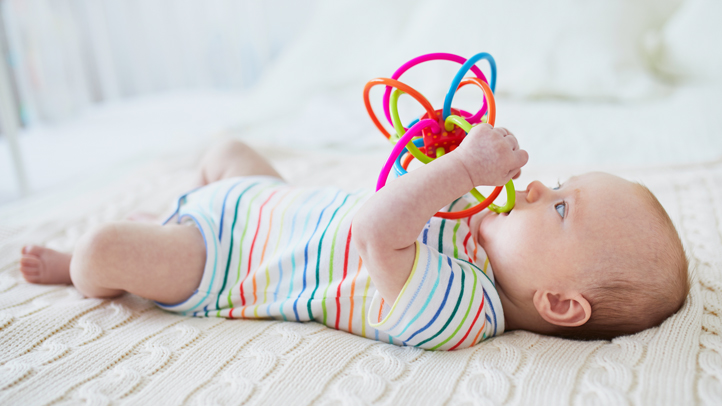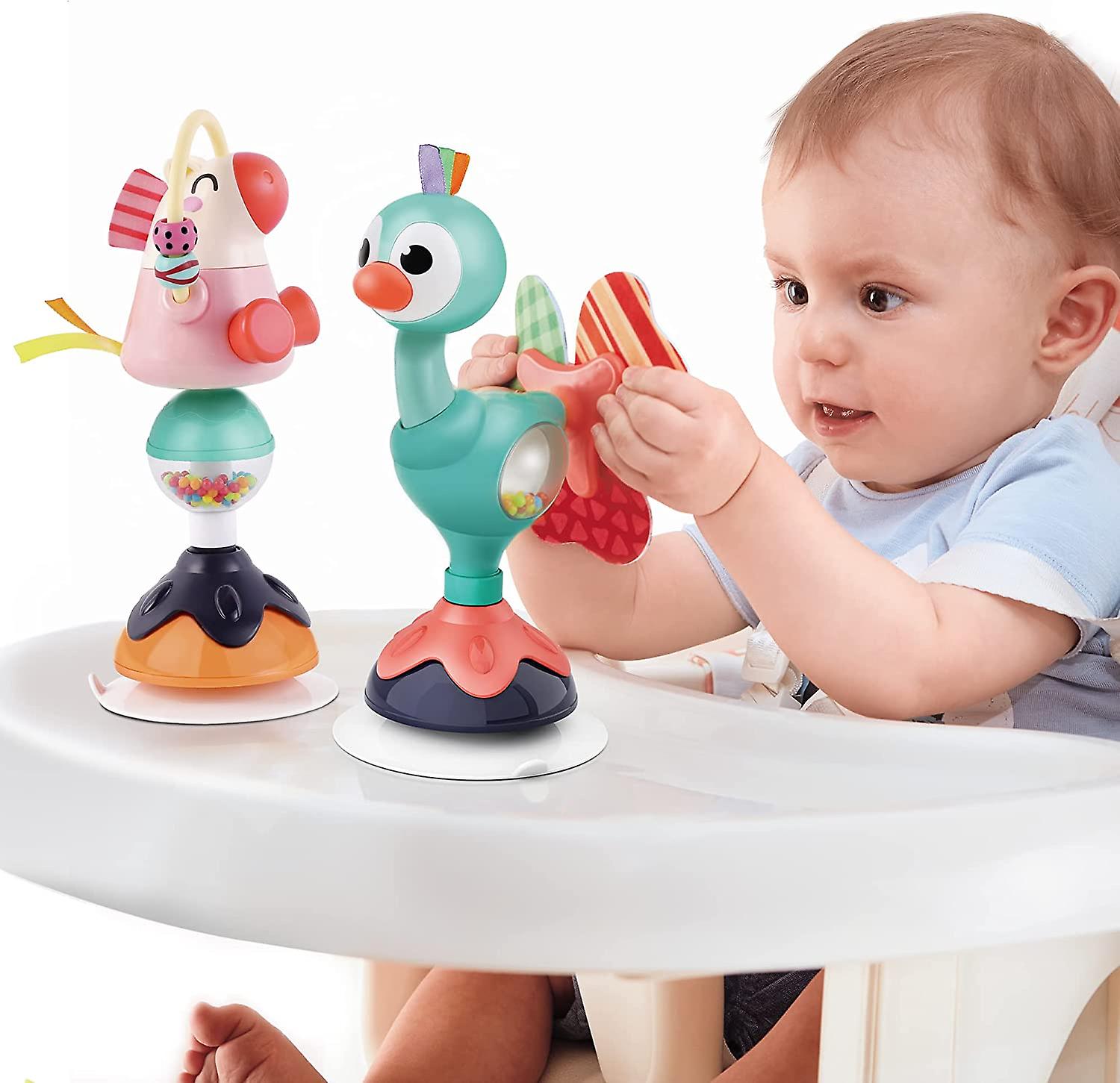When Do Babies Play With Toys? A Guide to Developmental Milestones
The world of a newborn is a whirlwind of new sights, sounds, and sensations. Every gurgle, coo, and wiggle is a sign of exploration and learning. But when does this exploration translate into play with toys? This is a question that many parents eagerly await the answer to.
While babies won’t be building intricate structures with Legos right away, their interaction with toys evolves significantly throughout their first year. Understanding these developmental milestones can help you choose age-appropriate toys and foster a love for play in your little one.
The Early Days: Sensory Exploration (0-3 Months)
In the first few months, a baby’s world revolves around their basic needs and exploring their immediate surroundings. Their senses are still developing, and their primary form of play involves taking in their environment.
- Sight: High-contrast mobiles and colorful toys capture a baby’s attention. They may track moving objects with their eyes.
- Touch: Soft blankets, textured rattles, and crinkly toys provide opportunities for tactile exploration. Babies will bring objects to their mouths to learn about them.
- Hearing: Gentle music, rattles, and your own voice all stimulate a baby’s auditory senses. They may startle at loud noises and find calming sounds soothing.
During this stage, you are your baby’s best toy. Engaging them in face-to-face interaction, singing songs, and narrating your actions all contribute to their development.
Reaching and Grasping: The Fun Begins (4-6 Months)
Around 4 months, babies gain greater control over their head and neck movements. They start reaching for objects and develop a grasp reflex. This is when play with toys truly begins!
- Focus on grasping and manipulating objects. Rwill pique their curiosity. High-contrast colors and interesting textures provide visual and tactile stimulation for babies. Look for toys that are safe for them to put in their mouths.
- Toys with contrasting colors and textures will pique their curiosity.
- Consider floor mats and activity gyms that provide a safe space for exploration. Floor mats and activity gyms offer a variety of textures, shapes, and objects for babies to explore while they are on their tummies or backs. These play spaces can help encourage reaching, grasping, and rolling over.
This is also the stage when babies begin to understand cause and effect. Shaking a rattle and hearing a sound, or batting at a mobile and watching it move, are fascinating discoveries for them. These early experiences help them learn that their actions can produce results, which is a foundational concept for future learning and development.
Sitting Up and Moving Around: Expanding Playtime (7-9 Months)
By 7 months, many babies can sit unsupported, and their hand-eye coordination improves significantly. This newfound mobility unlocks a whole new world of play possibilities, making this a truly exciting stage for both you and your little one!
Let’s explore some ways to expand playtime during this developmental leap:
- Toys that can be banged, pushed, or pulled: These encourage exploration of cause and effect in a more dynamic way. Look for toys with buttons that light up or make sounds when activated, or brightly colored stacking cups that can be knocked down with a gleeful giggle.
- Introduce stacking cups: Stacking cups come in various sizes and colors, allowing babies to experiment with grasping, fitting objects together, and understanding the concept of bigger and smaller. Watching them proudly build a tower (and then gleefully topple it over) is a delightful experience!
- Explore textures and sounds: Offer a variety of textured toys – soft plushies, bumpy balls, crinkly books – to further stimulate their developing senses of touch and sound.
- Activity centers: Consider activity centers that feature spinning gears, levers, and light-up buttons. These interactive play areas provide endless opportunities for exploration and keep curious minds engaged.
Choose toys that are age-appropriate and free from choking hazards. Regularly inspect toys for any damage and remove anything that could break off or become a loose part.
Object permanence also develops around this time. Peek-a-boo games and hiding toys become a source of amusement and learning. You can hide a favorite toy under a blanket and watch your baby’s delight when they rediscover it. This newfound understanding that objects exist even when out of sight is a significant cognitive leap!
Cruising and Crawling: Independent Exploration (10-12 Months)
Hold on tight, because this is when things get exciting! Between 10 and 12 months, your baby becomes a mobile explorer, cruising along furniture, crawling with newfound confidence, and reaching for everything in sight. This newfound independence translates into a whole new level of play, and here’s how you can nurture it:
- Fuel their movement: Push and pull toys become a favorite as they propel themselves around the room. Look for sturdy wagons they can load with treasures (or maybe the family pet!), brightly colored cars that zoom across the floor, or walkers that provide support for those early exploration steps.
- Challenge their minds: Shape sorters with chunky pieces present a fun problem-solving challenge. Watching them grasp a shape, figure out which slot it fits into, and triumphantly plop it in is a rewarding experience for both of you.
- Spark their curiosity: Board books with sturdy pages and captivating illustrations are a wonderful introduction to the world. Point to pictures, name the objects, and make silly sound effects to keep them engaged.
This is also the stage where preferences emerge. Your little one might gravitate towards certain toys or develop a special attachment to a beloved stuffed animal or soft blanket. This is a sign of their growing emotional connection to objects, so cherish these newfound companions!
Safety remains a priority. As your baby becomes more mobile, baby-proofing your home becomes even more crucial. Cover sharp corners, secure furniture to walls, and block off any dangerous areas. Always supervise playtime and be mindful of potential hazards.
Remember, this is a magical time of discovery and exploration. Let your baby take the lead, follow their interests, and provide a safe and stimulating environment filled with age-appropriate toys. Embrace the giggles, the wobbly steps, and the insatiable curiosity – it’s all part of the incredible journey of watching your child learn and grow through play!
Beyond the First Year: The World of Imagination (12 Months+)
As your child enters their second year, play becomes more symbolic and imaginative. They may pretend to talk on the phone, feed a doll, or push a toy car around, mimicking the world around them.
This is the time to introduce more complex toys like building blocks, dress-up clothes, and toy vehicles. Engaging in pretend play with your child helps develop their social skills, imagination, and creativity.
Remember, every baby develops at their own pace. These milestones are a general guideline, and there can be variations. The most important thing is to provide a safe and stimulating environment filled with age-appropriate toys and plenty of love and interaction. Watch your baby explore, experiment, and discover the joy of play!
